Case Study: Analyzing Business Cycles at Paradise Industries
VerifiedAdded on 2023/01/11
|15
|3158
|78
Case Study
AI Summary
This case study provides a comprehensive analysis of Paradise Industries, focusing on its expenditure and conversion cycles. It begins with system flowcharts illustrating these cycles, detailing the processes involved in purchasing and converting resources into cash. The analysis identifies weaknesses in internal controls, particularly in the expenditure cycle, highlighting structural and documentation issues. The study examines risks within the conversion cycle, such as payment delays, decline in liquidity, and various operational challenges like void invoices and inventory deficiencies. Recommendations are provided to mitigate these risks, including establishing cognitive management activity for better financial control, adjusting procedures for excesses, and establishing regulatory systems. The study emphasizes the importance of internal controls and suggests improvements aligned with the COSO internal control module to enhance overall business process efficiency and reduce potential financial risks. The analysis underscores the significance of a well-managed cash conversion cycle for the financial health and sustainability of the company.
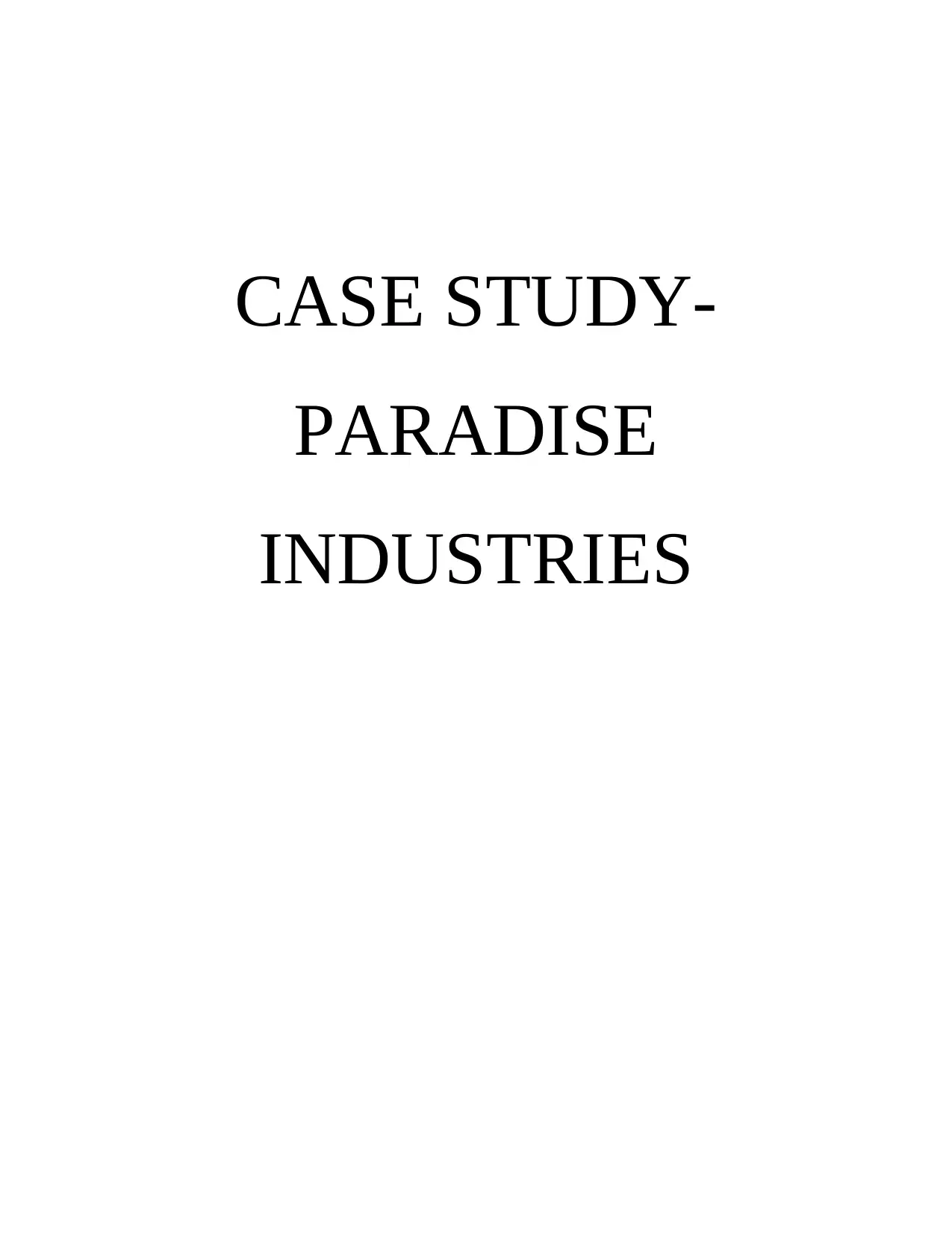
CASE STUDY-
PARADISE
INDUSTRIES
PARADISE
INDUSTRIES
Secure Best Marks with AI Grader
Need help grading? Try our AI Grader for instant feedback on your assignments.
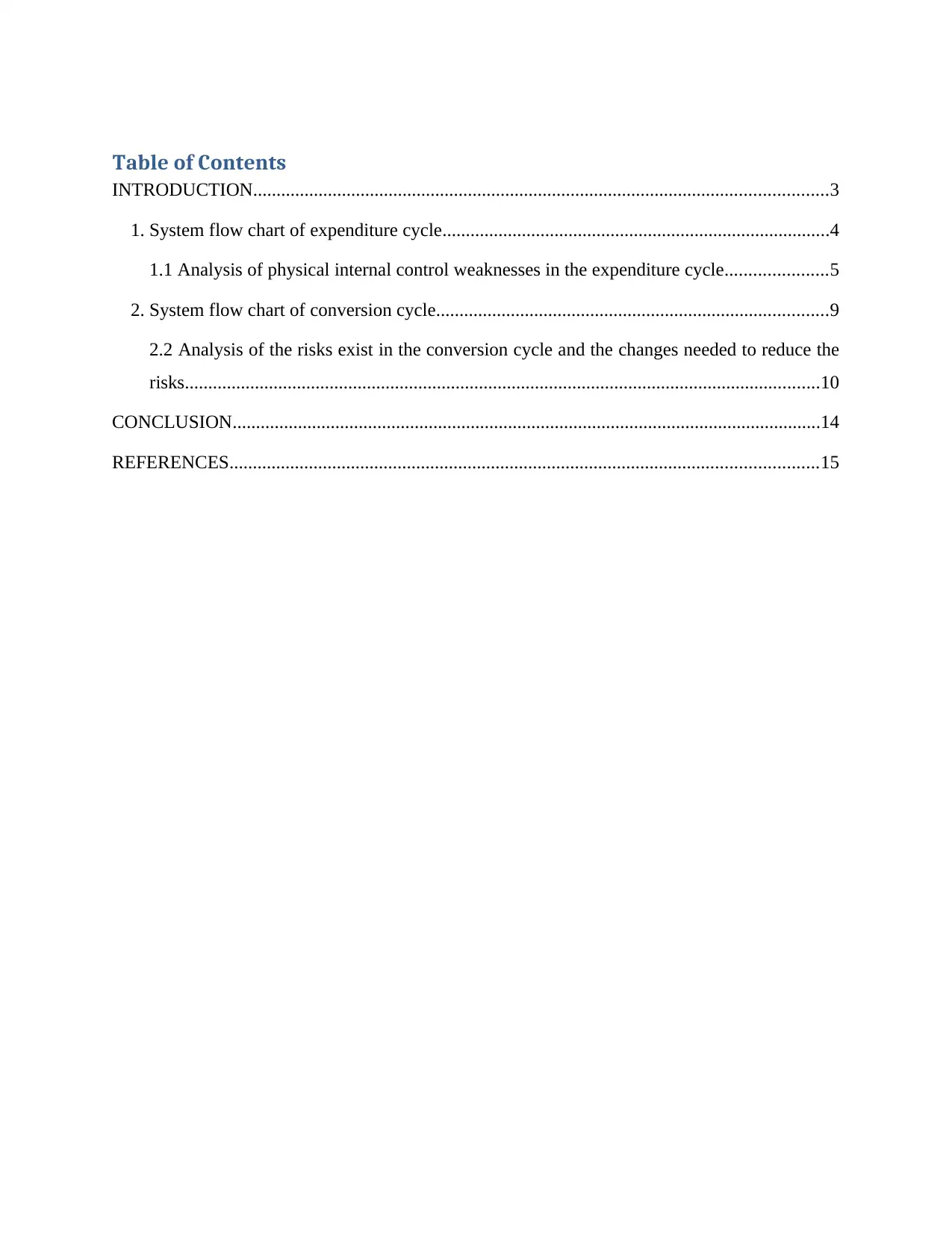
Table of Contents
INTRODUCTION...........................................................................................................................3
1. System flow chart of expenditure cycle...................................................................................4
1.1 Analysis of physical internal control weaknesses in the expenditure cycle......................5
2. System flow chart of conversion cycle....................................................................................9
2.2 Analysis of the risks exist in the conversion cycle and the changes needed to reduce the
risks........................................................................................................................................10
CONCLUSION..............................................................................................................................14
REFERENCES..............................................................................................................................15
INTRODUCTION...........................................................................................................................3
1. System flow chart of expenditure cycle...................................................................................4
1.1 Analysis of physical internal control weaknesses in the expenditure cycle......................5
2. System flow chart of conversion cycle....................................................................................9
2.2 Analysis of the risks exist in the conversion cycle and the changes needed to reduce the
risks........................................................................................................................................10
CONCLUSION..............................................................................................................................14
REFERENCES..............................................................................................................................15
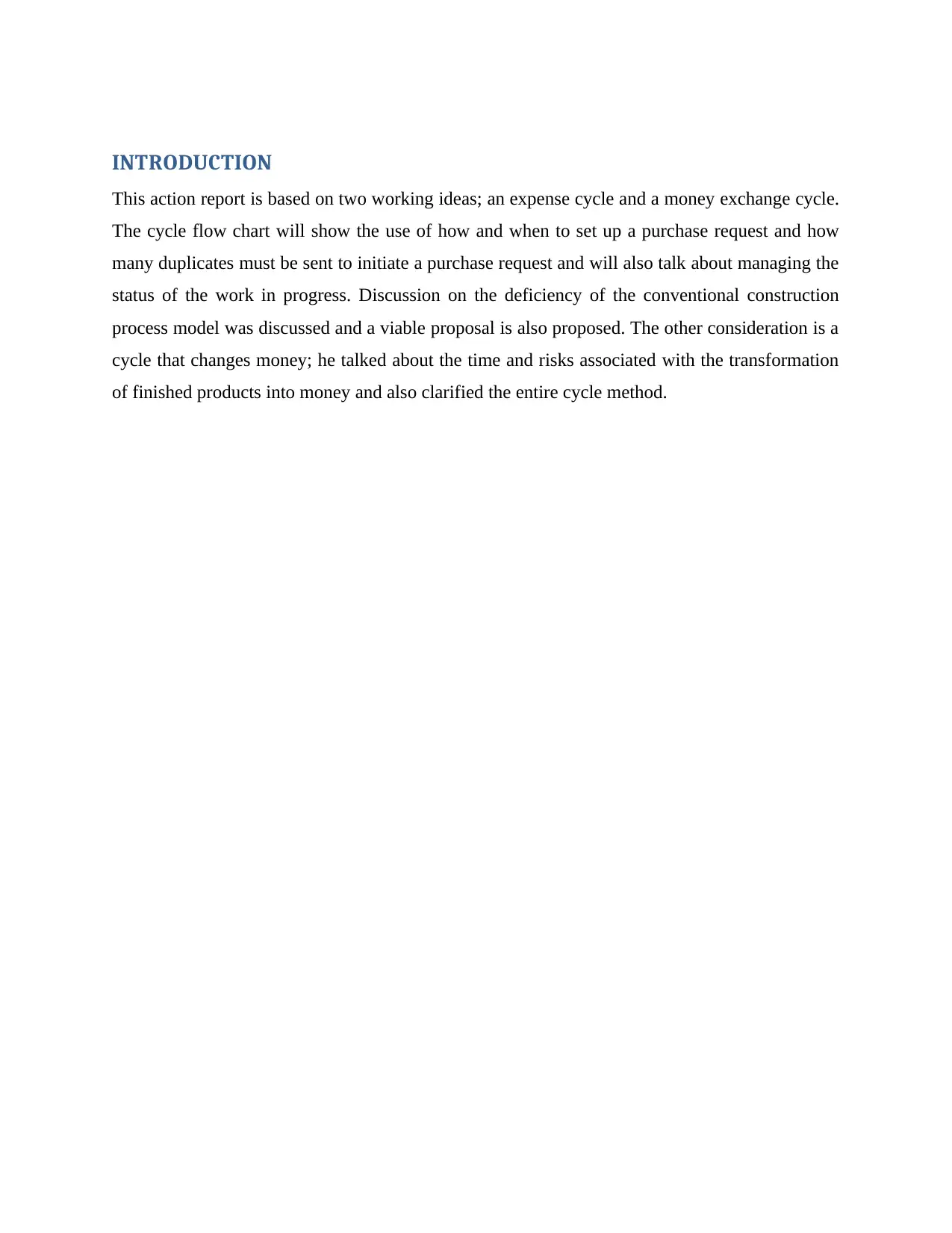
INTRODUCTION
This action report is based on two working ideas; an expense cycle and a money exchange cycle.
The cycle flow chart will show the use of how and when to set up a purchase request and how
many duplicates must be sent to initiate a purchase request and will also talk about managing the
status of the work in progress. Discussion on the deficiency of the conventional construction
process model was discussed and a viable proposal is also proposed. The other consideration is a
cycle that changes money; he talked about the time and risks associated with the transformation
of finished products into money and also clarified the entire cycle method.
This action report is based on two working ideas; an expense cycle and a money exchange cycle.
The cycle flow chart will show the use of how and when to set up a purchase request and how
many duplicates must be sent to initiate a purchase request and will also talk about managing the
status of the work in progress. Discussion on the deficiency of the conventional construction
process model was discussed and a viable proposal is also proposed. The other consideration is a
cycle that changes money; he talked about the time and risks associated with the transformation
of finished products into money and also clarified the entire cycle method.
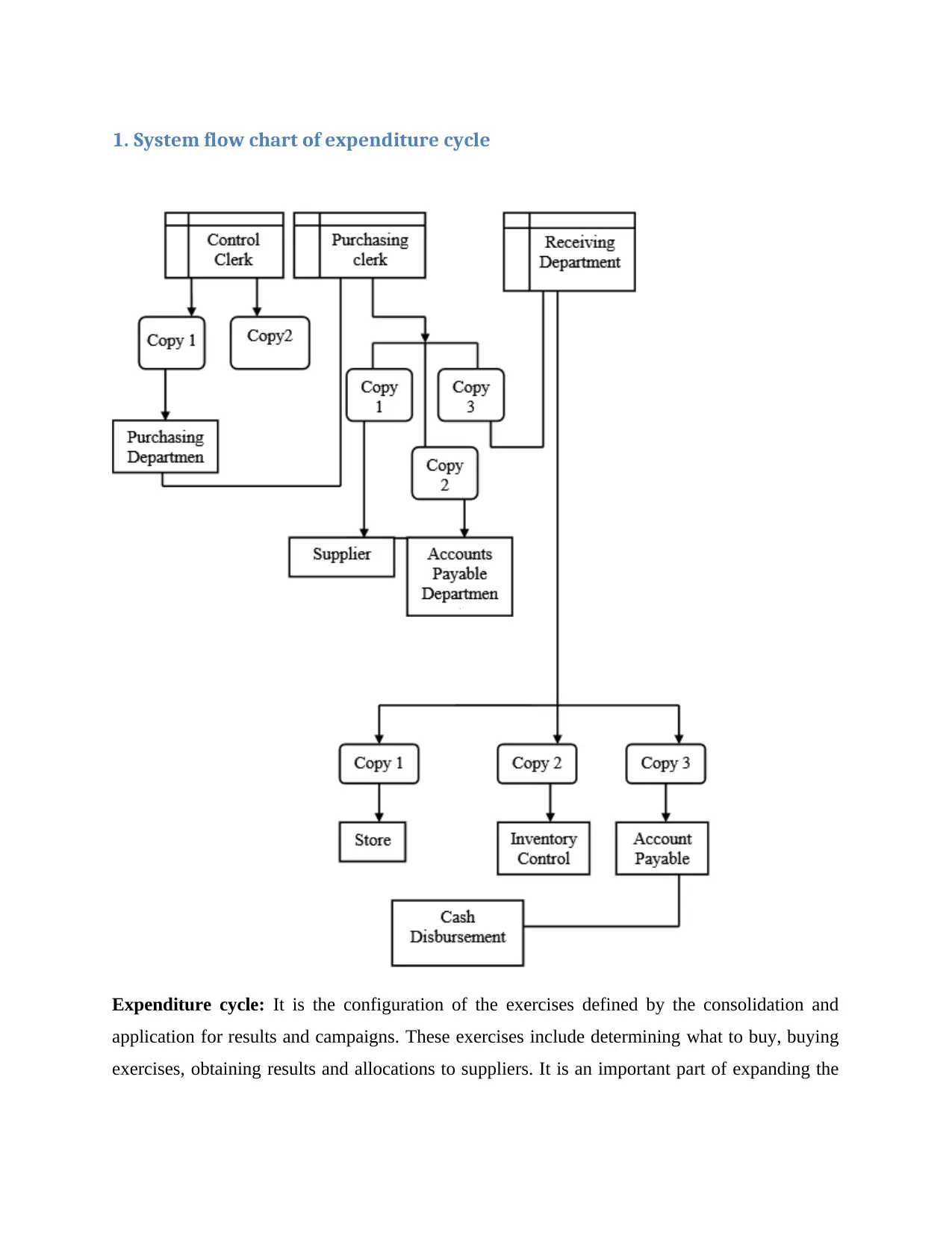
1. System flow chart of expenditure cycle
Expenditure cycle: It is the configuration of the exercises defined by the consolidation and
application for results and campaigns. These exercises include determining what to buy, buying
exercises, obtaining results and allocations to suppliers. It is an important part of expanding the
Expenditure cycle: It is the configuration of the exercises defined by the consolidation and
application for results and campaigns. These exercises include determining what to buy, buying
exercises, obtaining results and allocations to suppliers. It is an important part of expanding the
Secure Best Marks with AI Grader
Need help grading? Try our AI Grader for instant feedback on your assignments.
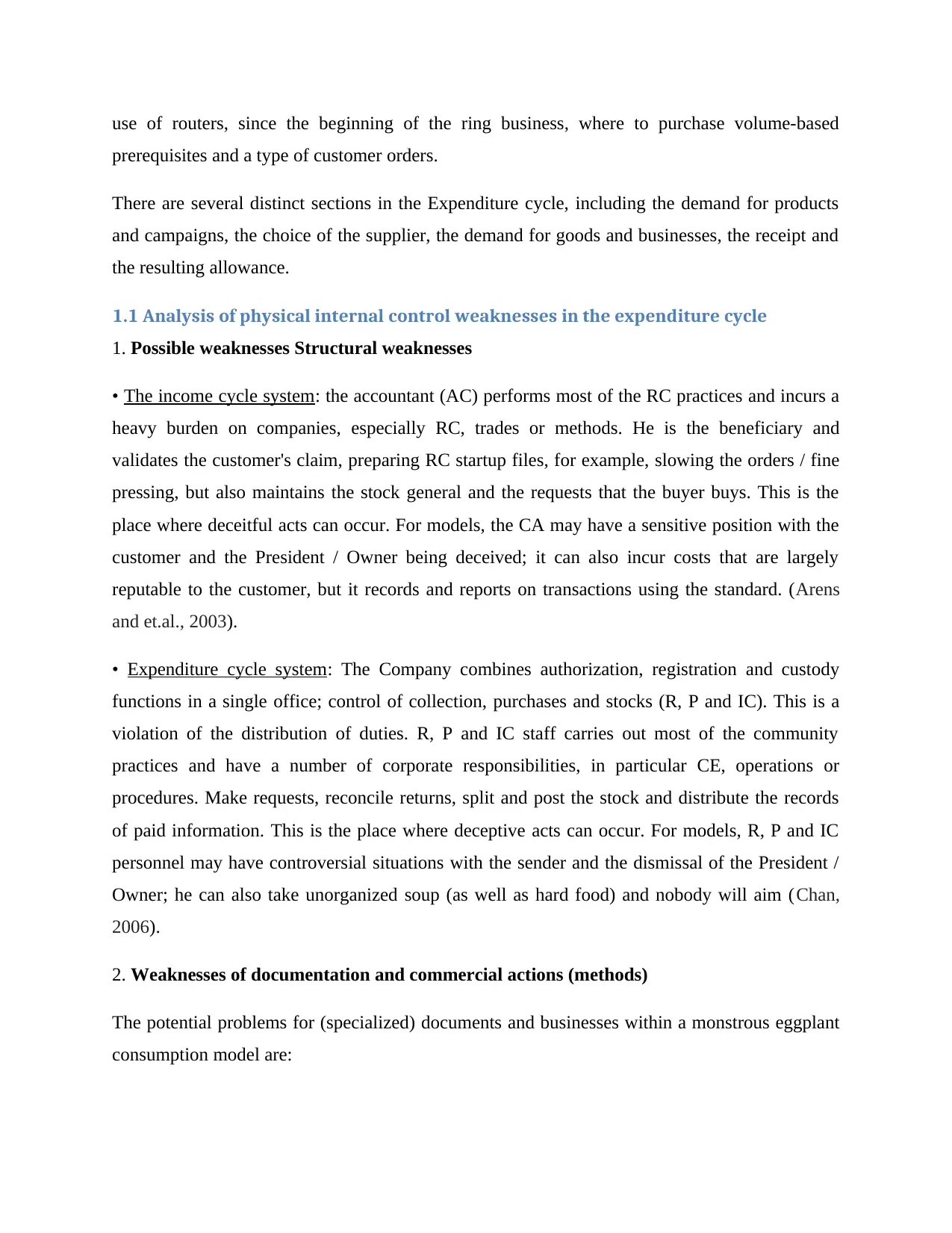
use of routers, since the beginning of the ring business, where to purchase volume-based
prerequisites and a type of customer orders.
There are several distinct sections in the Expenditure cycle, including the demand for products
and campaigns, the choice of the supplier, the demand for goods and businesses, the receipt and
the resulting allowance.
1.1 Analysis of physical internal control weaknesses in the expenditure cycle
1. Possible weaknesses Structural weaknesses
• The income cycle system: the accountant (AC) performs most of the RC practices and incurs a
heavy burden on companies, especially RC, trades or methods. He is the beneficiary and
validates the customer's claim, preparing RC startup files, for example, slowing the orders / fine
pressing, but also maintains the stock general and the requests that the buyer buys. This is the
place where deceitful acts can occur. For models, the CA may have a sensitive position with the
customer and the President / Owner being deceived; it can also incur costs that are largely
reputable to the customer, but it records and reports on transactions using the standard. (Arens
and et.al., 2003).
• Expenditure cycle system: The Company combines authorization, registration and custody
functions in a single office; control of collection, purchases and stocks (R, P and IC). This is a
violation of the distribution of duties. R, P and IC staff carries out most of the community
practices and have a number of corporate responsibilities, in particular CE, operations or
procedures. Make requests, reconcile returns, split and post the stock and distribute the records
of paid information. This is the place where deceptive acts can occur. For models, R, P and IC
personnel may have controversial situations with the sender and the dismissal of the President /
Owner; he can also take unorganized soup (as well as hard food) and nobody will aim (Chan,
2006).
2. Weaknesses of documentation and commercial actions (methods)
The potential problems for (specialized) documents and businesses within a monstrous eggplant
consumption model are:
prerequisites and a type of customer orders.
There are several distinct sections in the Expenditure cycle, including the demand for products
and campaigns, the choice of the supplier, the demand for goods and businesses, the receipt and
the resulting allowance.
1.1 Analysis of physical internal control weaknesses in the expenditure cycle
1. Possible weaknesses Structural weaknesses
• The income cycle system: the accountant (AC) performs most of the RC practices and incurs a
heavy burden on companies, especially RC, trades or methods. He is the beneficiary and
validates the customer's claim, preparing RC startup files, for example, slowing the orders / fine
pressing, but also maintains the stock general and the requests that the buyer buys. This is the
place where deceitful acts can occur. For models, the CA may have a sensitive position with the
customer and the President / Owner being deceived; it can also incur costs that are largely
reputable to the customer, but it records and reports on transactions using the standard. (Arens
and et.al., 2003).
• Expenditure cycle system: The Company combines authorization, registration and custody
functions in a single office; control of collection, purchases and stocks (R, P and IC). This is a
violation of the distribution of duties. R, P and IC staff carries out most of the community
practices and have a number of corporate responsibilities, in particular CE, operations or
procedures. Make requests, reconcile returns, split and post the stock and distribute the records
of paid information. This is the place where deceptive acts can occur. For models, R, P and IC
personnel may have controversial situations with the sender and the dismissal of the President /
Owner; he can also take unorganized soup (as well as hard food) and nobody will aim (Chan,
2006).
2. Weaknesses of documentation and commercial actions (methods)
The potential problems for (specialized) documents and businesses within a monstrous eggplant
consumption model are:
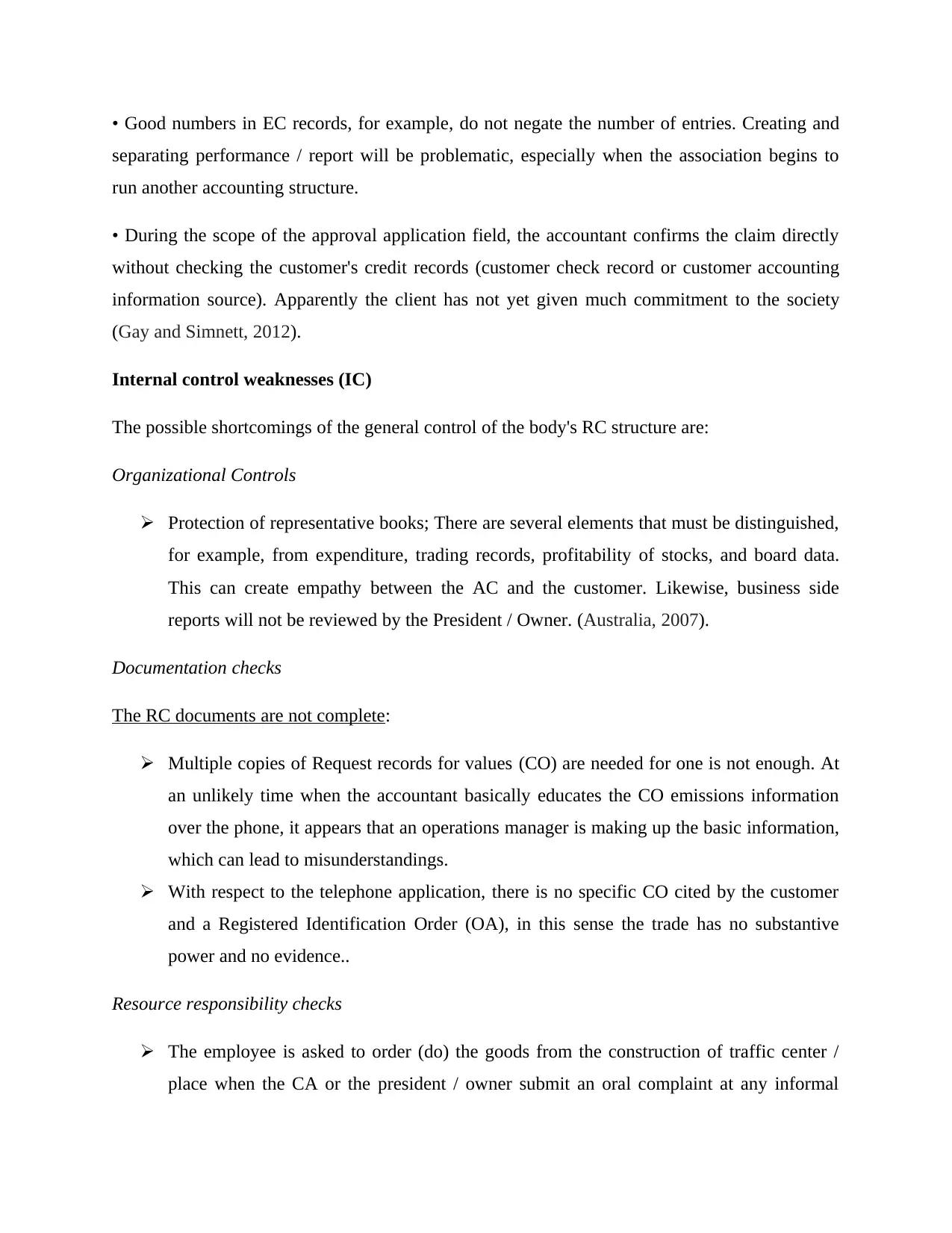
• Good numbers in EC records, for example, do not negate the number of entries. Creating and
separating performance / report will be problematic, especially when the association begins to
run another accounting structure.
• During the scope of the approval application field, the accountant confirms the claim directly
without checking the customer's credit records (customer check record or customer accounting
information source). Apparently the client has not yet given much commitment to the society
(Gay and Simnett, 2012).
Internal control weaknesses (IC)
The possible shortcomings of the general control of the body's RC structure are:
Organizational Controls
Protection of representative books; There are several elements that must be distinguished,
for example, from expenditure, trading records, profitability of stocks, and board data.
This can create empathy between the AC and the customer. Likewise, business side
reports will not be reviewed by the President / Owner. (Australia, 2007).
Documentation checks
The RC documents are not complete:
Multiple copies of Request records for values (CO) are needed for one is not enough. At
an unlikely time when the accountant basically educates the CO emissions information
over the phone, it appears that an operations manager is making up the basic information,
which can lead to misunderstandings.
With respect to the telephone application, there is no specific CO cited by the customer
and a Registered Identification Order (OA), in this sense the trade has no substantive
power and no evidence..
Resource responsibility checks
The employee is asked to order (do) the goods from the construction of traffic center /
place when the CA or the president / owner submit an oral complaint at any informal
separating performance / report will be problematic, especially when the association begins to
run another accounting structure.
• During the scope of the approval application field, the accountant confirms the claim directly
without checking the customer's credit records (customer check record or customer accounting
information source). Apparently the client has not yet given much commitment to the society
(Gay and Simnett, 2012).
Internal control weaknesses (IC)
The possible shortcomings of the general control of the body's RC structure are:
Organizational Controls
Protection of representative books; There are several elements that must be distinguished,
for example, from expenditure, trading records, profitability of stocks, and board data.
This can create empathy between the AC and the customer. Likewise, business side
reports will not be reviewed by the President / Owner. (Australia, 2007).
Documentation checks
The RC documents are not complete:
Multiple copies of Request records for values (CO) are needed for one is not enough. At
an unlikely time when the accountant basically educates the CO emissions information
over the phone, it appears that an operations manager is making up the basic information,
which can lead to misunderstandings.
With respect to the telephone application, there is no specific CO cited by the customer
and a Registered Identification Order (OA), in this sense the trade has no substantive
power and no evidence..
Resource responsibility checks
The employee is asked to order (do) the goods from the construction of traffic center /
place when the CA or the president / owner submit an oral complaint at any informal
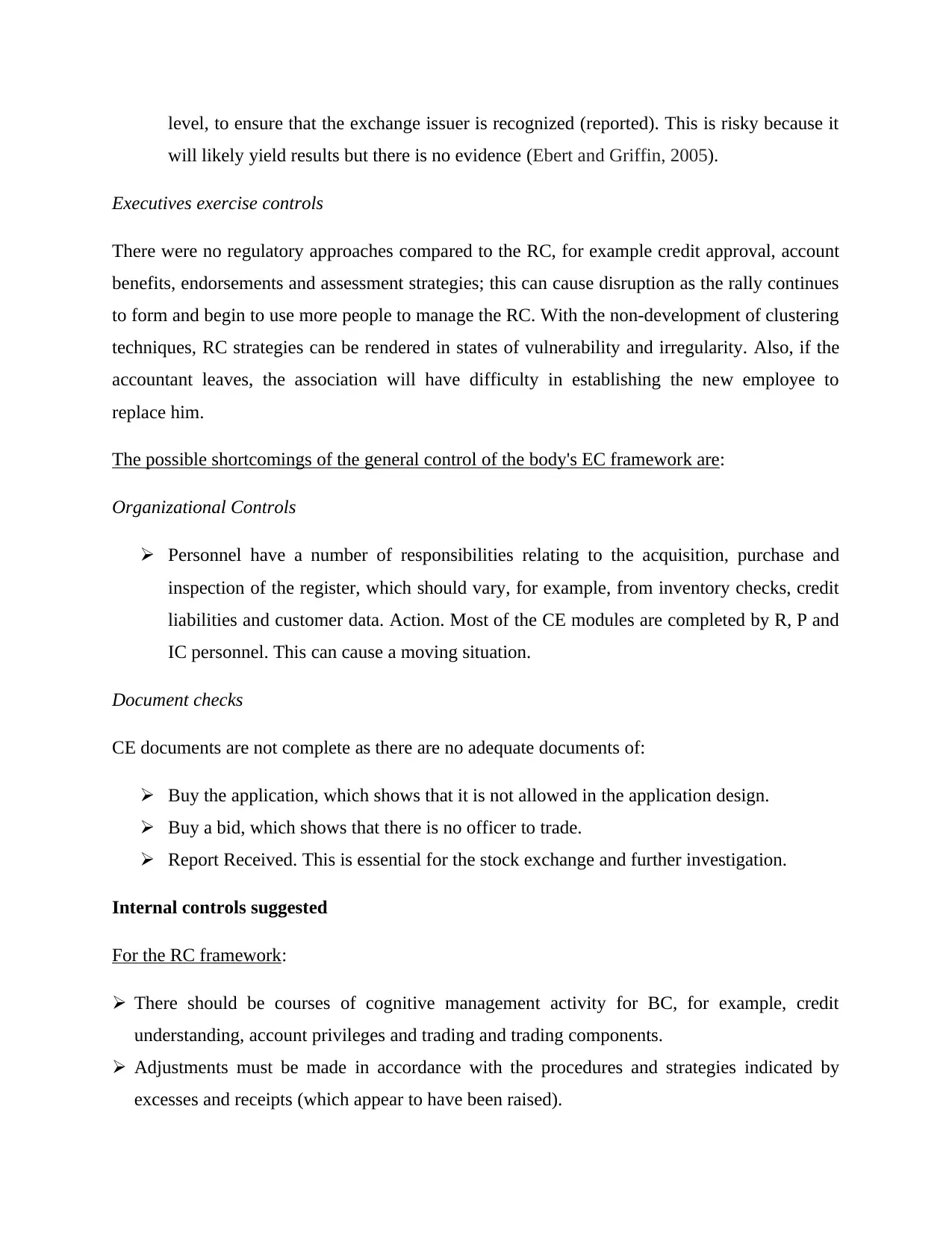
level, to ensure that the exchange issuer is recognized (reported). This is risky because it
will likely yield results but there is no evidence (Ebert and Griffin, 2005).
Executives exercise controls
There were no regulatory approaches compared to the RC, for example credit approval, account
benefits, endorsements and assessment strategies; this can cause disruption as the rally continues
to form and begin to use more people to manage the RC. With the non-development of clustering
techniques, RC strategies can be rendered in states of vulnerability and irregularity. Also, if the
accountant leaves, the association will have difficulty in establishing the new employee to
replace him.
The possible shortcomings of the general control of the body's EC framework are:
Organizational Controls
Personnel have a number of responsibilities relating to the acquisition, purchase and
inspection of the register, which should vary, for example, from inventory checks, credit
liabilities and customer data. Action. Most of the CE modules are completed by R, P and
IC personnel. This can cause a moving situation.
Document checks
CE documents are not complete as there are no adequate documents of:
Buy the application, which shows that it is not allowed in the application design.
Buy a bid, which shows that there is no officer to trade.
Report Received. This is essential for the stock exchange and further investigation.
Internal controls suggested
For the RC framework:
There should be courses of cognitive management activity for BC, for example, credit
understanding, account privileges and trading and trading components.
Adjustments must be made in accordance with the procedures and strategies indicated by
excesses and receipts (which appear to have been raised).
will likely yield results but there is no evidence (Ebert and Griffin, 2005).
Executives exercise controls
There were no regulatory approaches compared to the RC, for example credit approval, account
benefits, endorsements and assessment strategies; this can cause disruption as the rally continues
to form and begin to use more people to manage the RC. With the non-development of clustering
techniques, RC strategies can be rendered in states of vulnerability and irregularity. Also, if the
accountant leaves, the association will have difficulty in establishing the new employee to
replace him.
The possible shortcomings of the general control of the body's EC framework are:
Organizational Controls
Personnel have a number of responsibilities relating to the acquisition, purchase and
inspection of the register, which should vary, for example, from inventory checks, credit
liabilities and customer data. Action. Most of the CE modules are completed by R, P and
IC personnel. This can cause a moving situation.
Document checks
CE documents are not complete as there are no adequate documents of:
Buy the application, which shows that it is not allowed in the application design.
Buy a bid, which shows that there is no officer to trade.
Report Received. This is essential for the stock exchange and further investigation.
Internal controls suggested
For the RC framework:
There should be courses of cognitive management activity for BC, for example, credit
understanding, account privileges and trading and trading components.
Adjustments must be made in accordance with the procedures and strategies indicated by
excesses and receipts (which appear to have been raised).
Paraphrase This Document
Need a fresh take? Get an instant paraphrase of this document with our AI Paraphraser
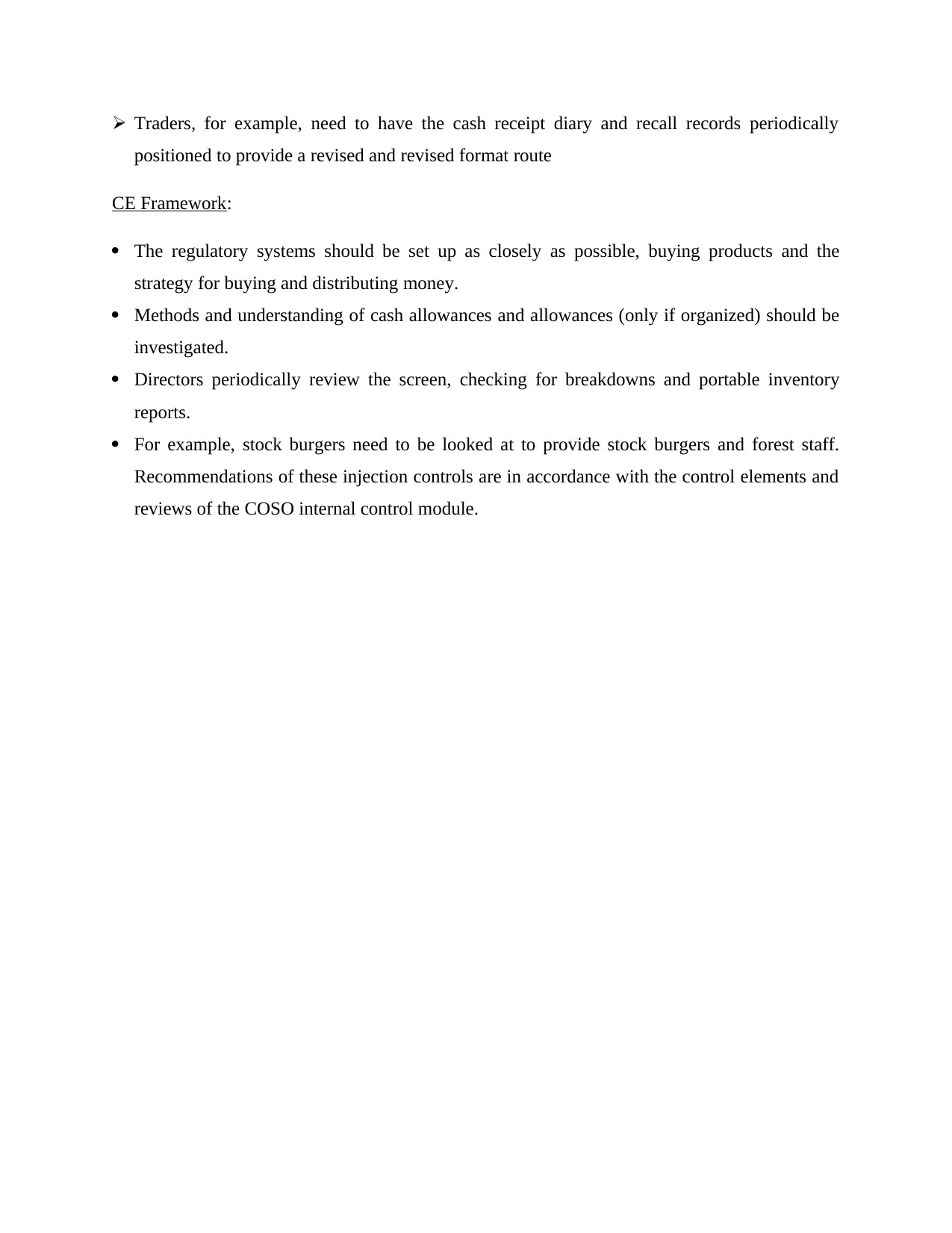
Traders, for example, need to have the cash receipt diary and recall records periodically
positioned to provide a revised and revised format route
CE Framework:
The regulatory systems should be set up as closely as possible, buying products and the
strategy for buying and distributing money.
Methods and understanding of cash allowances and allowances (only if organized) should be
investigated.
Directors periodically review the screen, checking for breakdowns and portable inventory
reports.
For example, stock burgers need to be looked at to provide stock burgers and forest staff.
Recommendations of these injection controls are in accordance with the control elements and
reviews of the COSO internal control module.
positioned to provide a revised and revised format route
CE Framework:
The regulatory systems should be set up as closely as possible, buying products and the
strategy for buying and distributing money.
Methods and understanding of cash allowances and allowances (only if organized) should be
investigated.
Directors periodically review the screen, checking for breakdowns and portable inventory
reports.
For example, stock burgers need to be looked at to provide stock burgers and forest staff.
Recommendations of these injection controls are in accordance with the control elements and
reviews of the COSO internal control module.
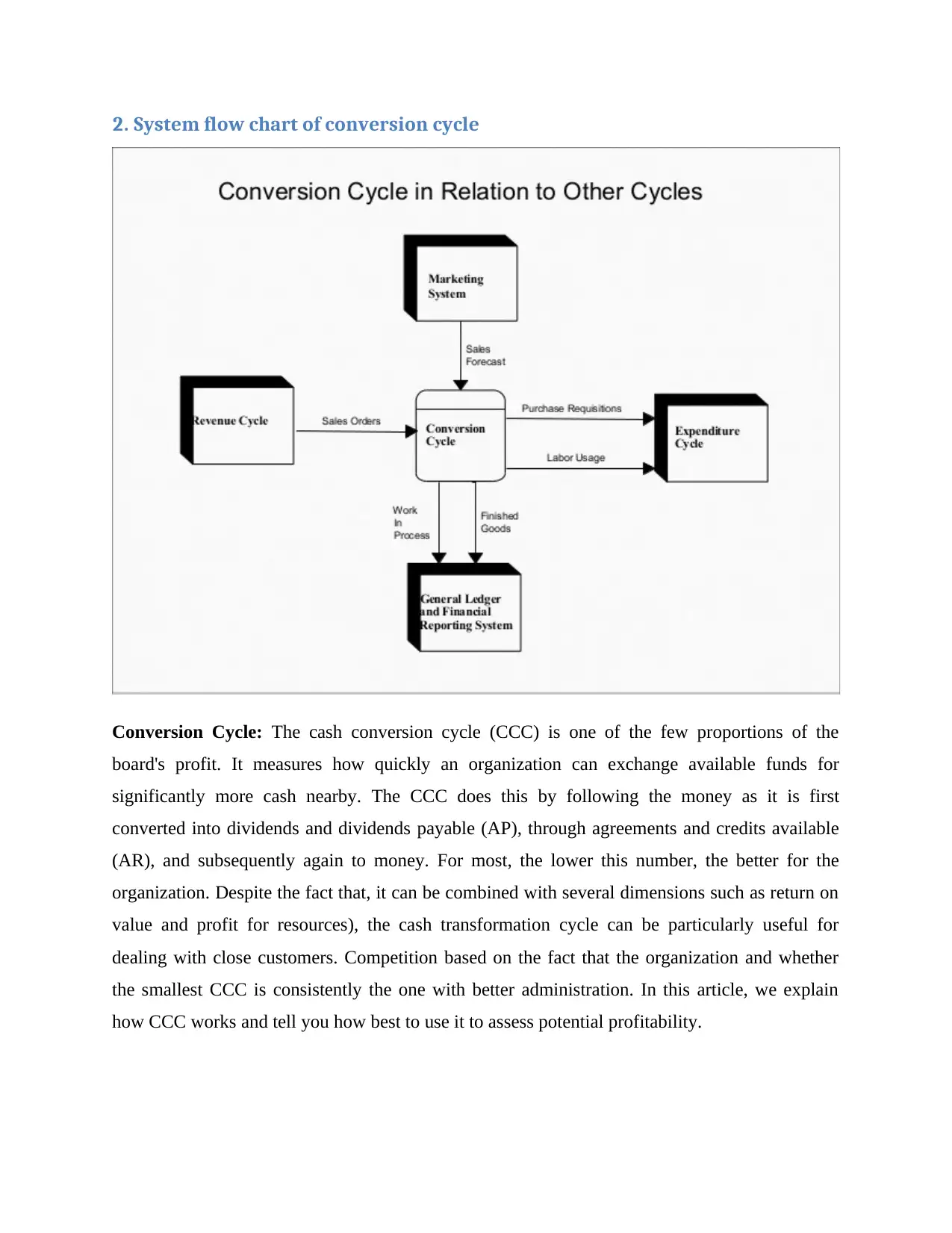
2. System flow chart of conversion cycle
Conversion Cycle: The cash conversion cycle (CCC) is one of the few proportions of the
board's profit. It measures how quickly an organization can exchange available funds for
significantly more cash nearby. The CCC does this by following the money as it is first
converted into dividends and dividends payable (AP), through agreements and credits available
(AR), and subsequently again to money. For most, the lower this number, the better for the
organization. Despite the fact that, it can be combined with several dimensions such as return on
value and profit for resources), the cash transformation cycle can be particularly useful for
dealing with close customers. Competition based on the fact that the organization and whether
the smallest CCC is consistently the one with better administration. In this article, we explain
how CCC works and tell you how best to use it to assess potential profitability.
Conversion Cycle: The cash conversion cycle (CCC) is one of the few proportions of the
board's profit. It measures how quickly an organization can exchange available funds for
significantly more cash nearby. The CCC does this by following the money as it is first
converted into dividends and dividends payable (AP), through agreements and credits available
(AR), and subsequently again to money. For most, the lower this number, the better for the
organization. Despite the fact that, it can be combined with several dimensions such as return on
value and profit for resources), the cash transformation cycle can be particularly useful for
dealing with close customers. Competition based on the fact that the organization and whether
the smallest CCC is consistently the one with better administration. In this article, we explain
how CCC works and tell you how best to use it to assess potential profitability.
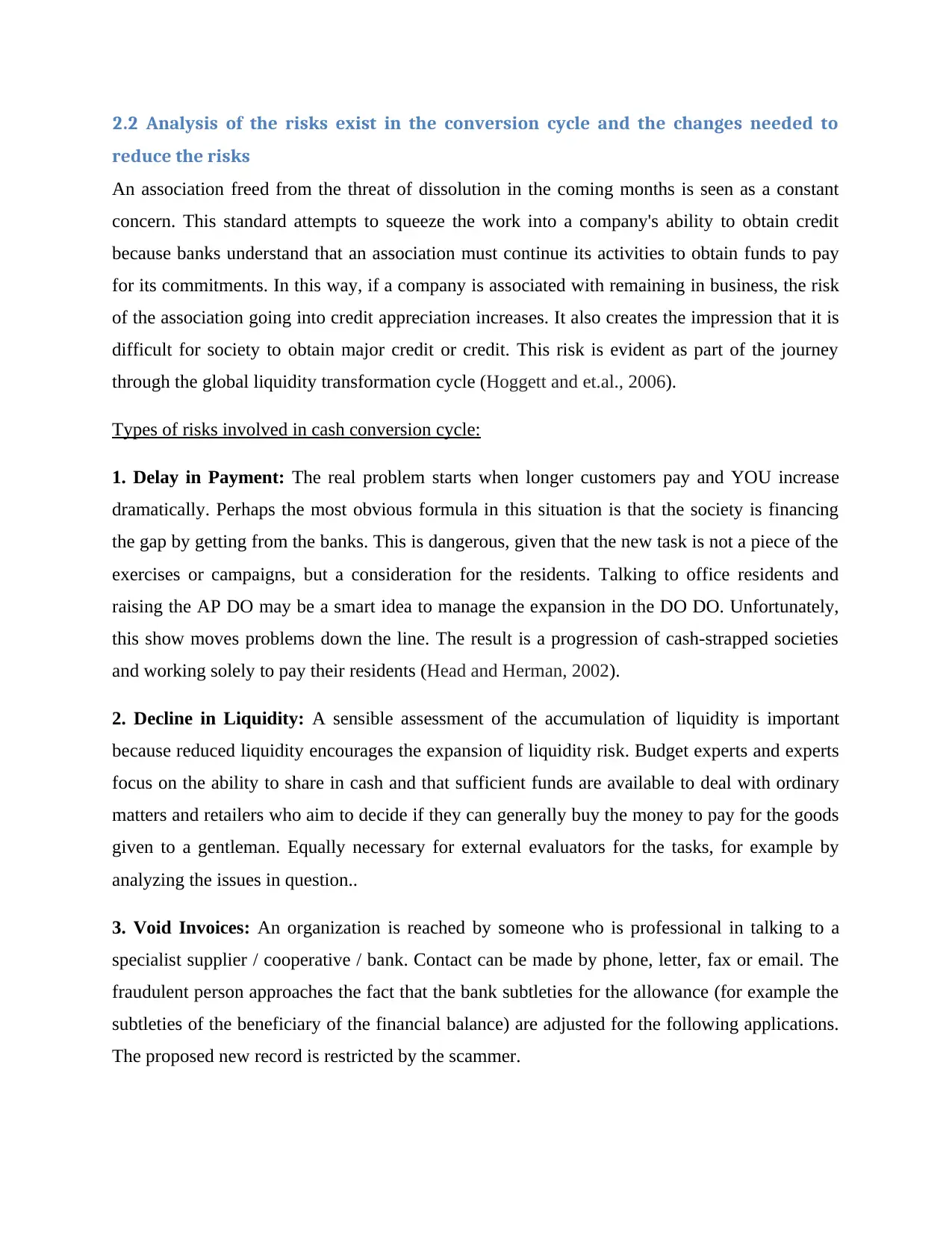
2.2 Analysis of the risks exist in the conversion cycle and the changes needed to
reduce the risks
An association freed from the threat of dissolution in the coming months is seen as a constant
concern. This standard attempts to squeeze the work into a company's ability to obtain credit
because banks understand that an association must continue its activities to obtain funds to pay
for its commitments. In this way, if a company is associated with remaining in business, the risk
of the association going into credit appreciation increases. It also creates the impression that it is
difficult for society to obtain major credit or credit. This risk is evident as part of the journey
through the global liquidity transformation cycle (Hoggett and et.al., 2006).
Types of risks involved in cash conversion cycle:
1. Delay in Payment: The real problem starts when longer customers pay and YOU increase
dramatically. Perhaps the most obvious formula in this situation is that the society is financing
the gap by getting from the banks. This is dangerous, given that the new task is not a piece of the
exercises or campaigns, but a consideration for the residents. Talking to office residents and
raising the AP DO may be a smart idea to manage the expansion in the DO DO. Unfortunately,
this show moves problems down the line. The result is a progression of cash-strapped societies
and working solely to pay their residents (Head and Herman, 2002).
2. Decline in Liquidity: A sensible assessment of the accumulation of liquidity is important
because reduced liquidity encourages the expansion of liquidity risk. Budget experts and experts
focus on the ability to share in cash and that sufficient funds are available to deal with ordinary
matters and retailers who aim to decide if they can generally buy the money to pay for the goods
given to a gentleman. Equally necessary for external evaluators for the tasks, for example by
analyzing the issues in question..
3. Void Invoices: An organization is reached by someone who is professional in talking to a
specialist supplier / cooperative / bank. Contact can be made by phone, letter, fax or email. The
fraudulent person approaches the fact that the bank subtleties for the allowance (for example the
subtleties of the beneficiary of the financial balance) are adjusted for the following applications.
The proposed new record is restricted by the scammer.
reduce the risks
An association freed from the threat of dissolution in the coming months is seen as a constant
concern. This standard attempts to squeeze the work into a company's ability to obtain credit
because banks understand that an association must continue its activities to obtain funds to pay
for its commitments. In this way, if a company is associated with remaining in business, the risk
of the association going into credit appreciation increases. It also creates the impression that it is
difficult for society to obtain major credit or credit. This risk is evident as part of the journey
through the global liquidity transformation cycle (Hoggett and et.al., 2006).
Types of risks involved in cash conversion cycle:
1. Delay in Payment: The real problem starts when longer customers pay and YOU increase
dramatically. Perhaps the most obvious formula in this situation is that the society is financing
the gap by getting from the banks. This is dangerous, given that the new task is not a piece of the
exercises or campaigns, but a consideration for the residents. Talking to office residents and
raising the AP DO may be a smart idea to manage the expansion in the DO DO. Unfortunately,
this show moves problems down the line. The result is a progression of cash-strapped societies
and working solely to pay their residents (Head and Herman, 2002).
2. Decline in Liquidity: A sensible assessment of the accumulation of liquidity is important
because reduced liquidity encourages the expansion of liquidity risk. Budget experts and experts
focus on the ability to share in cash and that sufficient funds are available to deal with ordinary
matters and retailers who aim to decide if they can generally buy the money to pay for the goods
given to a gentleman. Equally necessary for external evaluators for the tasks, for example by
analyzing the issues in question..
3. Void Invoices: An organization is reached by someone who is professional in talking to a
specialist supplier / cooperative / bank. Contact can be made by phone, letter, fax or email. The
fraudulent person approaches the fact that the bank subtleties for the allowance (for example the
subtleties of the beneficiary of the financial balance) are adjusted for the following applications.
The proposed new record is restricted by the scammer.
Secure Best Marks with AI Grader
Need help grading? Try our AI Grader for instant feedback on your assignments.
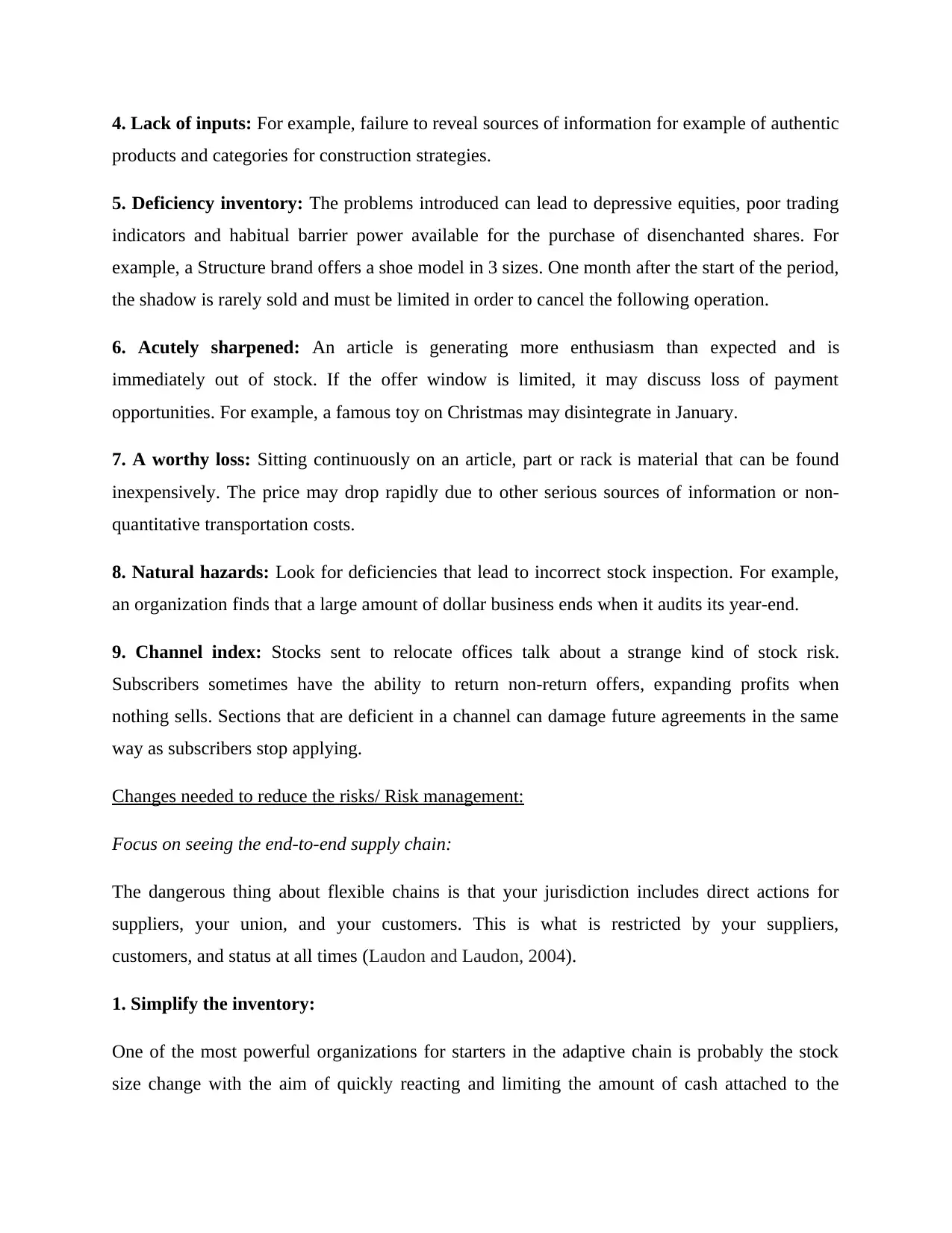
4. Lack of inputs: For example, failure to reveal sources of information for example of authentic
products and categories for construction strategies.
5. Deficiency inventory: The problems introduced can lead to depressive equities, poor trading
indicators and habitual barrier power available for the purchase of disenchanted shares. For
example, a Structure brand offers a shoe model in 3 sizes. One month after the start of the period,
the shadow is rarely sold and must be limited in order to cancel the following operation.
6. Acutely sharpened: An article is generating more enthusiasm than expected and is
immediately out of stock. If the offer window is limited, it may discuss loss of payment
opportunities. For example, a famous toy on Christmas may disintegrate in January.
7. A worthy loss: Sitting continuously on an article, part or rack is material that can be found
inexpensively. The price may drop rapidly due to other serious sources of information or non-
quantitative transportation costs.
8. Natural hazards: Look for deficiencies that lead to incorrect stock inspection. For example,
an organization finds that a large amount of dollar business ends when it audits its year-end.
9. Channel index: Stocks sent to relocate offices talk about a strange kind of stock risk.
Subscribers sometimes have the ability to return non-return offers, expanding profits when
nothing sells. Sections that are deficient in a channel can damage future agreements in the same
way as subscribers stop applying.
Changes needed to reduce the risks/ Risk management:
Focus on seeing the end-to-end supply chain:
The dangerous thing about flexible chains is that your jurisdiction includes direct actions for
suppliers, your union, and your customers. This is what is restricted by your suppliers,
customers, and status at all times (Laudon and Laudon, 2004).
1. Simplify the inventory:
One of the most powerful organizations for starters in the adaptive chain is probably the stock
size change with the aim of quickly reacting and limiting the amount of cash attached to the
products and categories for construction strategies.
5. Deficiency inventory: The problems introduced can lead to depressive equities, poor trading
indicators and habitual barrier power available for the purchase of disenchanted shares. For
example, a Structure brand offers a shoe model in 3 sizes. One month after the start of the period,
the shadow is rarely sold and must be limited in order to cancel the following operation.
6. Acutely sharpened: An article is generating more enthusiasm than expected and is
immediately out of stock. If the offer window is limited, it may discuss loss of payment
opportunities. For example, a famous toy on Christmas may disintegrate in January.
7. A worthy loss: Sitting continuously on an article, part or rack is material that can be found
inexpensively. The price may drop rapidly due to other serious sources of information or non-
quantitative transportation costs.
8. Natural hazards: Look for deficiencies that lead to incorrect stock inspection. For example,
an organization finds that a large amount of dollar business ends when it audits its year-end.
9. Channel index: Stocks sent to relocate offices talk about a strange kind of stock risk.
Subscribers sometimes have the ability to return non-return offers, expanding profits when
nothing sells. Sections that are deficient in a channel can damage future agreements in the same
way as subscribers stop applying.
Changes needed to reduce the risks/ Risk management:
Focus on seeing the end-to-end supply chain:
The dangerous thing about flexible chains is that your jurisdiction includes direct actions for
suppliers, your union, and your customers. This is what is restricted by your suppliers,
customers, and status at all times (Laudon and Laudon, 2004).
1. Simplify the inventory:
One of the most powerful organizations for starters in the adaptive chain is probably the stock
size change with the aim of quickly reacting and limiting the amount of cash attached to the
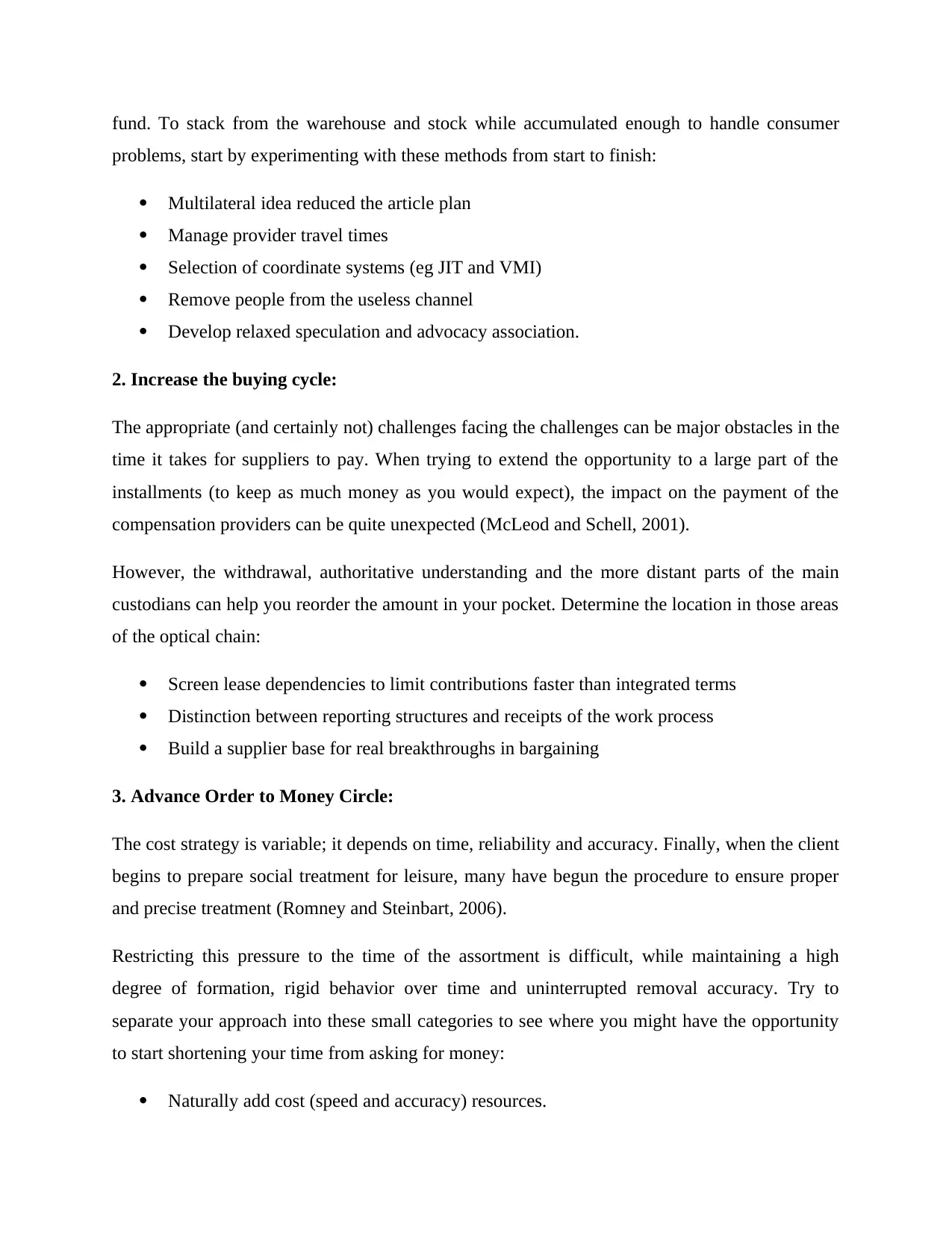
fund. To stack from the warehouse and stock while accumulated enough to handle consumer
problems, start by experimenting with these methods from start to finish:
Multilateral idea reduced the article plan
Manage provider travel times
Selection of coordinate systems (eg JIT and VMI)
Remove people from the useless channel
Develop relaxed speculation and advocacy association.
2. Increase the buying cycle:
The appropriate (and certainly not) challenges facing the challenges can be major obstacles in the
time it takes for suppliers to pay. When trying to extend the opportunity to a large part of the
installments (to keep as much money as you would expect), the impact on the payment of the
compensation providers can be quite unexpected (McLeod and Schell, 2001).
However, the withdrawal, authoritative understanding and the more distant parts of the main
custodians can help you reorder the amount in your pocket. Determine the location in those areas
of the optical chain:
Screen lease dependencies to limit contributions faster than integrated terms
Distinction between reporting structures and receipts of the work process
Build a supplier base for real breakthroughs in bargaining
3. Advance Order to Money Circle:
The cost strategy is variable; it depends on time, reliability and accuracy. Finally, when the client
begins to prepare social treatment for leisure, many have begun the procedure to ensure proper
and precise treatment (Romney and Steinbart, 2006).
Restricting this pressure to the time of the assortment is difficult, while maintaining a high
degree of formation, rigid behavior over time and uninterrupted removal accuracy. Try to
separate your approach into these small categories to see where you might have the opportunity
to start shortening your time from asking for money:
Naturally add cost (speed and accuracy) resources.
problems, start by experimenting with these methods from start to finish:
Multilateral idea reduced the article plan
Manage provider travel times
Selection of coordinate systems (eg JIT and VMI)
Remove people from the useless channel
Develop relaxed speculation and advocacy association.
2. Increase the buying cycle:
The appropriate (and certainly not) challenges facing the challenges can be major obstacles in the
time it takes for suppliers to pay. When trying to extend the opportunity to a large part of the
installments (to keep as much money as you would expect), the impact on the payment of the
compensation providers can be quite unexpected (McLeod and Schell, 2001).
However, the withdrawal, authoritative understanding and the more distant parts of the main
custodians can help you reorder the amount in your pocket. Determine the location in those areas
of the optical chain:
Screen lease dependencies to limit contributions faster than integrated terms
Distinction between reporting structures and receipts of the work process
Build a supplier base for real breakthroughs in bargaining
3. Advance Order to Money Circle:
The cost strategy is variable; it depends on time, reliability and accuracy. Finally, when the client
begins to prepare social treatment for leisure, many have begun the procedure to ensure proper
and precise treatment (Romney and Steinbart, 2006).
Restricting this pressure to the time of the assortment is difficult, while maintaining a high
degree of formation, rigid behavior over time and uninterrupted removal accuracy. Try to
separate your approach into these small categories to see where you might have the opportunity
to start shortening your time from asking for money:
Naturally add cost (speed and accuracy) resources.
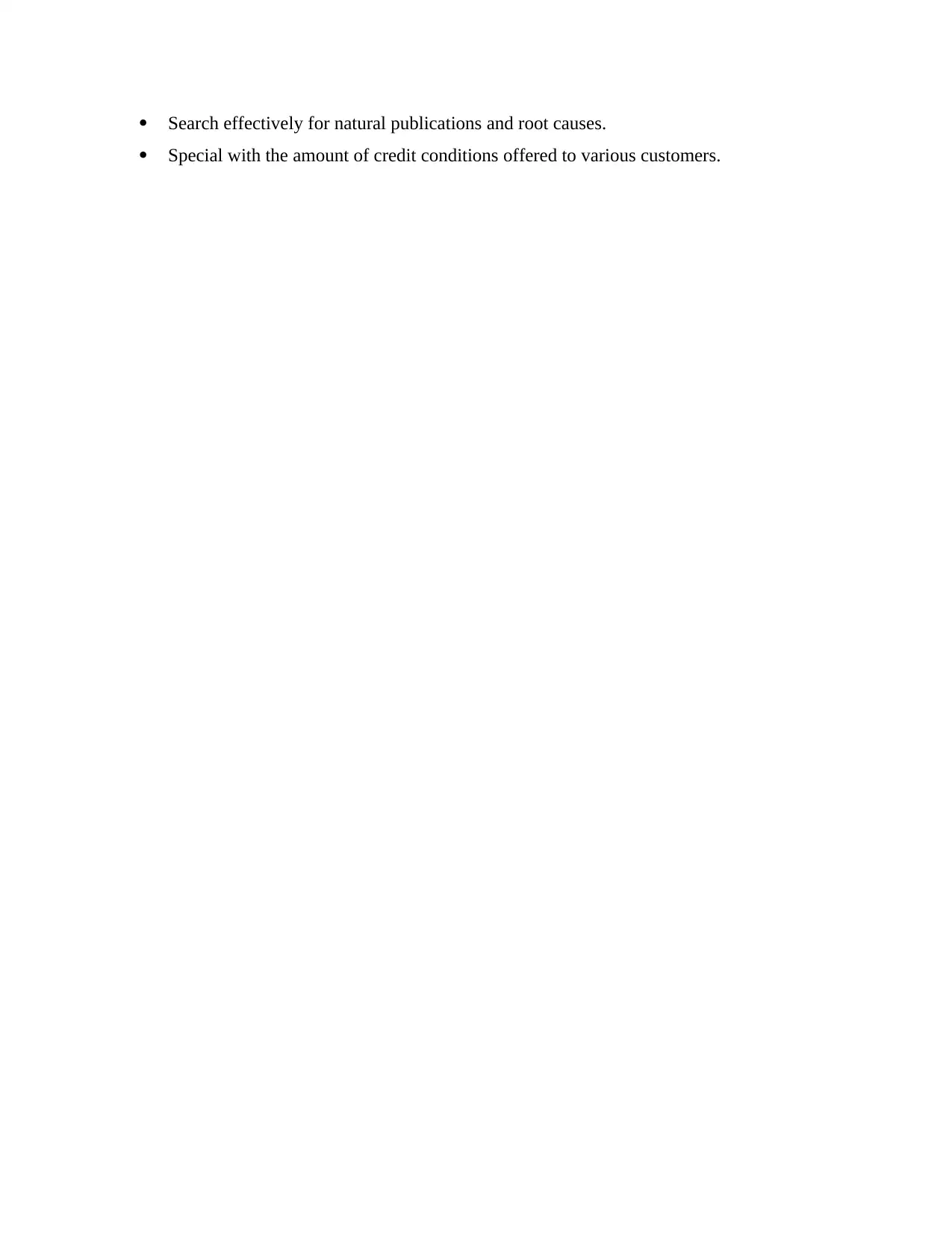
Search effectively for natural publications and root causes.
Special with the amount of credit conditions offered to various customers.
Special with the amount of credit conditions offered to various customers.
Paraphrase This Document
Need a fresh take? Get an instant paraphrase of this document with our AI Paraphraser
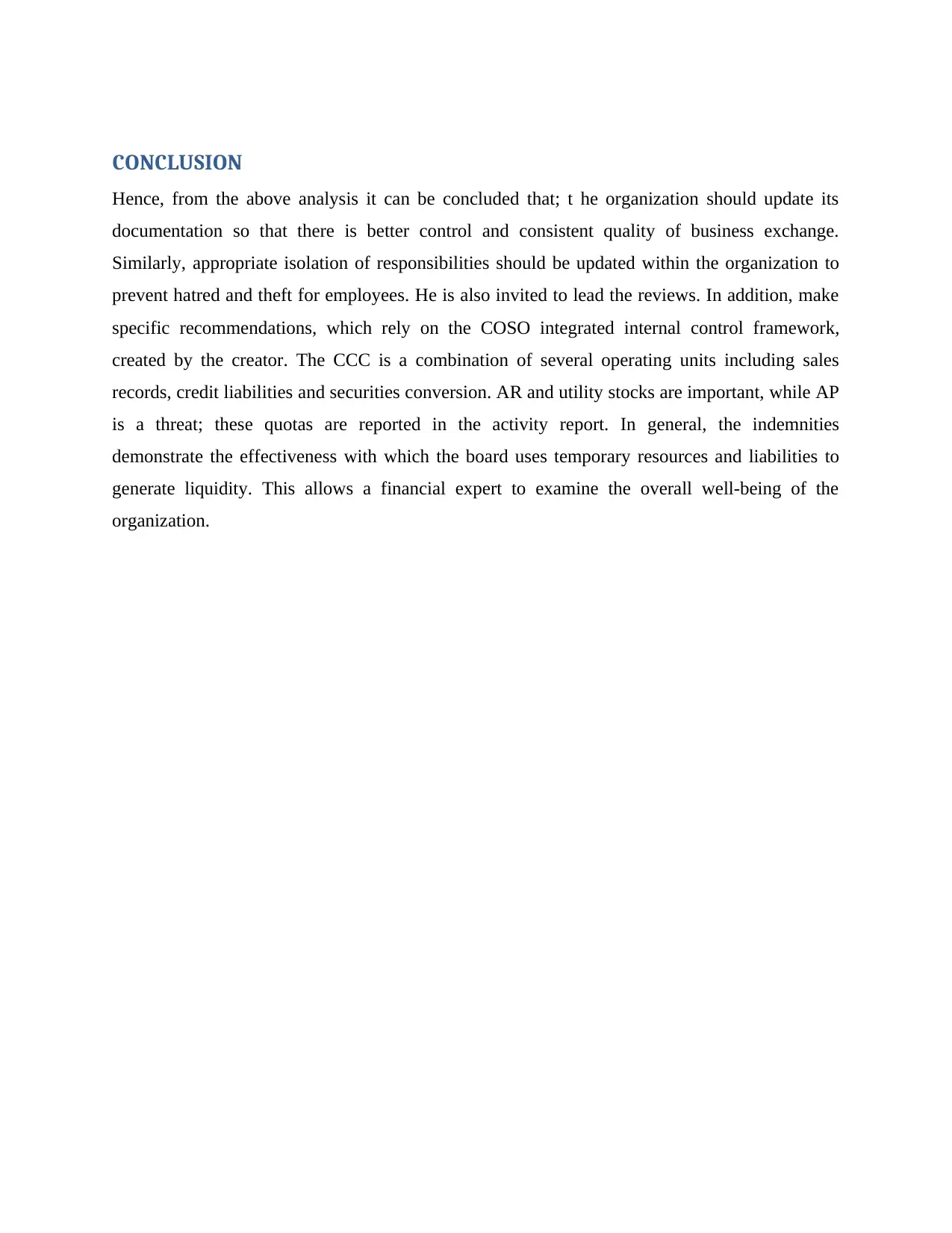
CONCLUSION
Hence, from the above analysis it can be concluded that; t he organization should update its
documentation so that there is better control and consistent quality of business exchange.
Similarly, appropriate isolation of responsibilities should be updated within the organization to
prevent hatred and theft for employees. He is also invited to lead the reviews. In addition, make
specific recommendations, which rely on the COSO integrated internal control framework,
created by the creator. The CCC is a combination of several operating units including sales
records, credit liabilities and securities conversion. AR and utility stocks are important, while AP
is a threat; these quotas are reported in the activity report. In general, the indemnities
demonstrate the effectiveness with which the board uses temporary resources and liabilities to
generate liquidity. This allows a financial expert to examine the overall well-being of the
organization.
Hence, from the above analysis it can be concluded that; t he organization should update its
documentation so that there is better control and consistent quality of business exchange.
Similarly, appropriate isolation of responsibilities should be updated within the organization to
prevent hatred and theft for employees. He is also invited to lead the reviews. In addition, make
specific recommendations, which rely on the COSO integrated internal control framework,
created by the creator. The CCC is a combination of several operating units including sales
records, credit liabilities and securities conversion. AR and utility stocks are important, while AP
is a threat; these quotas are reported in the activity report. In general, the indemnities
demonstrate the effectiveness with which the board uses temporary resources and liabilities to
generate liquidity. This allows a financial expert to examine the overall well-being of the
organization.
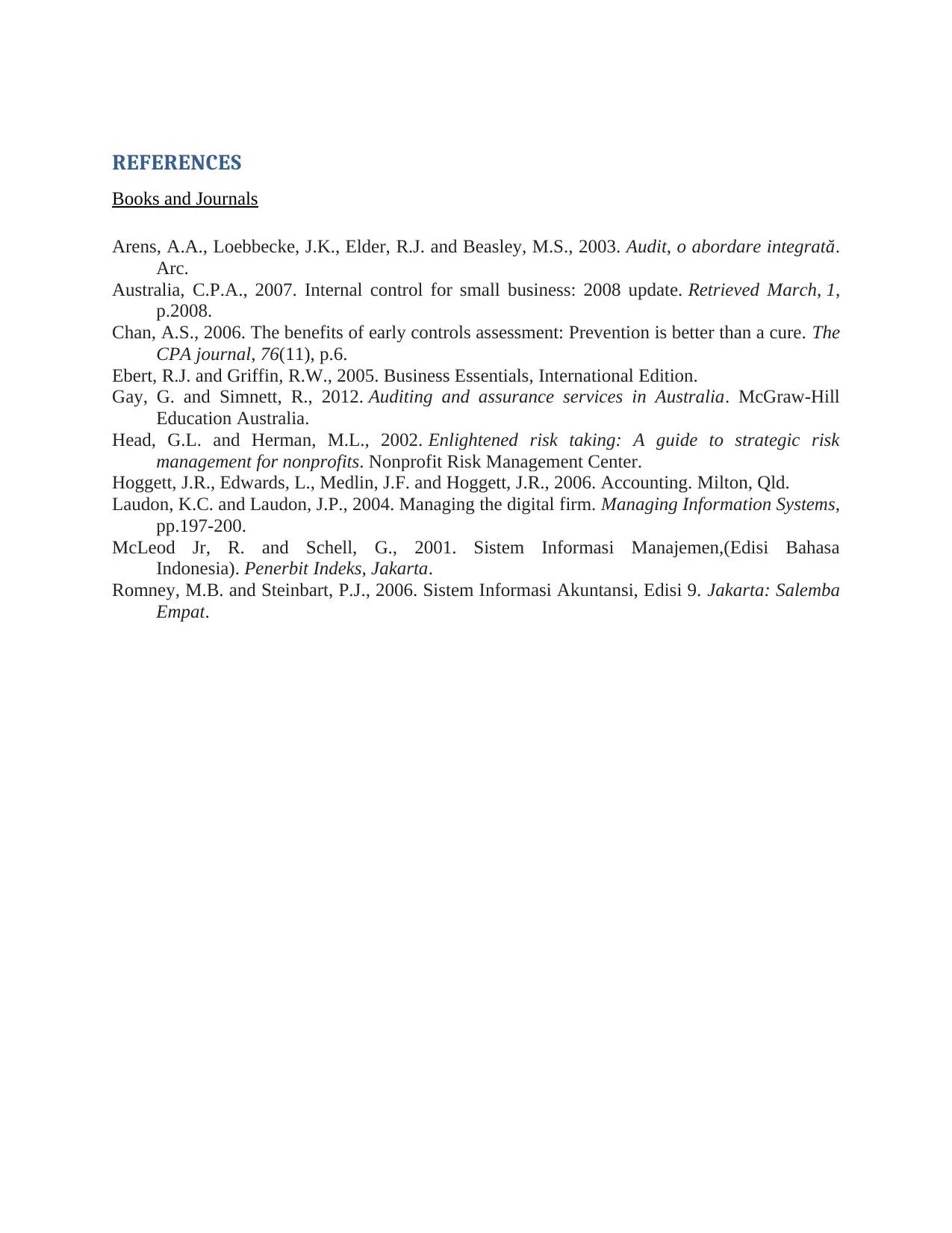
REFERENCES
Books and Journals
Arens, A.A., Loebbecke, J.K., Elder, R.J. and Beasley, M.S., 2003. Audit, o abordare integrată.
Arc.
Australia, C.P.A., 2007. Internal control for small business: 2008 update. Retrieved March, 1,
p.2008.
Chan, A.S., 2006. The benefits of early controls assessment: Prevention is better than a cure. The
CPA journal, 76(11), p.6.
Ebert, R.J. and Griffin, R.W., 2005. Business Essentials, International Edition.
Gay, G. and Simnett, R., 2012. Auditing and assurance services in Australia. McGraw-Hill
Education Australia.
Head, G.L. and Herman, M.L., 2002. Enlightened risk taking: A guide to strategic risk
management for nonprofits. Nonprofit Risk Management Center.
Hoggett, J.R., Edwards, L., Medlin, J.F. and Hoggett, J.R., 2006. Accounting. Milton, Qld.
Laudon, K.C. and Laudon, J.P., 2004. Managing the digital firm. Managing Information Systems,
pp.197-200.
McLeod Jr, R. and Schell, G., 2001. Sistem Informasi Manajemen,(Edisi Bahasa
Indonesia). Penerbit Indeks, Jakarta.
Romney, M.B. and Steinbart, P.J., 2006. Sistem Informasi Akuntansi, Edisi 9. Jakarta: Salemba
Empat.
Books and Journals
Arens, A.A., Loebbecke, J.K., Elder, R.J. and Beasley, M.S., 2003. Audit, o abordare integrată.
Arc.
Australia, C.P.A., 2007. Internal control for small business: 2008 update. Retrieved March, 1,
p.2008.
Chan, A.S., 2006. The benefits of early controls assessment: Prevention is better than a cure. The
CPA journal, 76(11), p.6.
Ebert, R.J. and Griffin, R.W., 2005. Business Essentials, International Edition.
Gay, G. and Simnett, R., 2012. Auditing and assurance services in Australia. McGraw-Hill
Education Australia.
Head, G.L. and Herman, M.L., 2002. Enlightened risk taking: A guide to strategic risk
management for nonprofits. Nonprofit Risk Management Center.
Hoggett, J.R., Edwards, L., Medlin, J.F. and Hoggett, J.R., 2006. Accounting. Milton, Qld.
Laudon, K.C. and Laudon, J.P., 2004. Managing the digital firm. Managing Information Systems,
pp.197-200.
McLeod Jr, R. and Schell, G., 2001. Sistem Informasi Manajemen,(Edisi Bahasa
Indonesia). Penerbit Indeks, Jakarta.
Romney, M.B. and Steinbart, P.J., 2006. Sistem Informasi Akuntansi, Edisi 9. Jakarta: Salemba
Empat.
1 out of 15
Related Documents
Your All-in-One AI-Powered Toolkit for Academic Success.
+13062052269
info@desklib.com
Available 24*7 on WhatsApp / Email
![[object Object]](/_next/static/media/star-bottom.7253800d.svg)
Unlock your academic potential
© 2024 | Zucol Services PVT LTD | All rights reserved.





